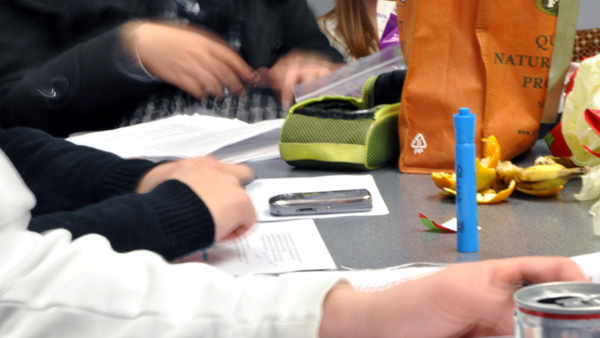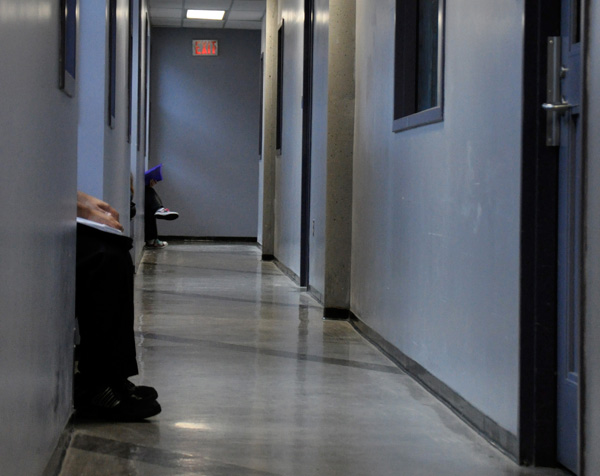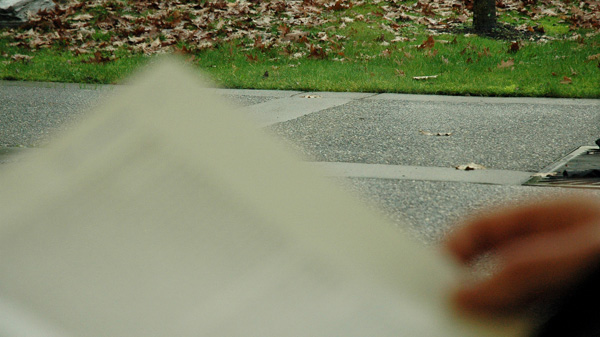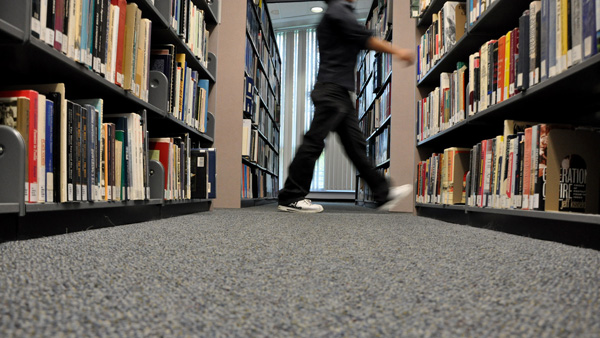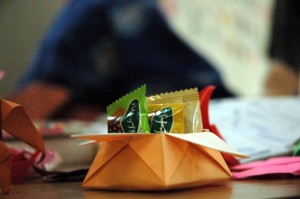Dominos Pizza promotion to send a child to UK soccer camp
January 30, 2011 by Brittany Tiplady · Leave a Comment
The KSA is hosting a Domino’s pizza promotion on Monday, Jan. 31, which is
designed to help send the child of a Kwantlen student to soccer camp.
“This promotion is being conducted in conjunction with Kwantlen student Rae-lynn Dicks, who is also the mother of a 12-year-old boy. We are trying to send her son to a UK soccer school, to be scouted by the UK premier soccer league,” said Colin Pearson, member services coordinator for the KSA.
“The trip is $5,000, so we are trying to raise just enough to cover transaction costs.”
Joshua has shown a talent for soccer, and the opportunity to train at this camp would heighten his chances for a soccer career.
Students can help Joshua and his mom by purchasing a Domino’s Pizza Value book, at the KSA members services office, for $10.50. Coupons in the book are valid anywhere in the Lower Mainland until Nov. 30.
The promotion will be continue until the beginning of March.
All was atwitter at Canadian University Press conference
January 23, 2011 by Brittany Tiplady · Leave a Comment
The National Canadian University Press (CUP) conference in Montreal was an opportunity for eager university students to mingle, but face-to-face socializing took a back burner to social media.
The 73rd annual CUP conference took place Jan. 12-16 in Montreal. Editorial staff from The Runner, Kwantlen’s independent newspaper, attended the conference along with approximately 300 student journalists, editors and designers from around the country.
Twitter not only was valuable addition to the conference, but a tool for 300 students to communicate instantaneously, showing the prominent voice Twitter has in the world of new media.
“It was cool to see what other people were thinking about specific things. In particular, there were a lot of people tweeting during a few of the keynote presentations, which kind of lightened the load on a couple of fairly snore-heavy speeches,” said Brad Michelson, the culture editor at UVic’s newspaper, The Martlet.
“Then again, it was cool to see what people’s plans were and to hear about restaurants, bars in town. It was just a cool social tool.”
The convenience of being able to speak to the person next to you, while keeping up with rest of the conference updates through Twitter, enhanced the Nash (a short form of “national”) experience and emphasized the importance of journalists receiving and using information from multiple sources.
“Aside from a tool for research, Twitter is also really useful for promoting one’s publication and work. Social media has been a blessing and a curse for media as a whole, but I prefer to think that it’s helping develop new media and evolving how media works,” said Michelson.
At each keynote, seminar and social event, iPhones and Blackberries were put to use while students documented each of the highs and lows.
“Twitter, in particular, allowed people to interact socially during times where they normally wouldn’t be, like speeches, and seminars. People could make commentaries, discuss opinions and share their general thoughts and impressions. I really enjoyed that kind of sub-culture, part of the conference,” said Michelson.
Twitter at Nash became the easiest way to find fellow students with similar interests.
Andrew Bates tweeted: “I’ve been getting follows and wondering ‘what, I wasn’t following these people already?’ This is almost entirely because of #nash73.”
“Great to meet (now connected) to so many smart journos. Thanks for your time. Loved meeting you all,” tweeted Wilf Dinnick.
Students continually refreshed the #nash73 feed in order to review a constant stream of updates on everything from seminars to critiques of the catering to hangover complaints.
“It was pretty entertaining to read through the #nash73 hash-tag throughout the conference. Everything from commentary on presentations or keynotes to seeing what other conference people were up to. It was definitely an source of entertainment that actually enhanced my experience there,” said Michelson.
“Last night’s drunken tweets are the best breakfast reading ever #nash73,” tweeted Sarah Petz.
Tweets sent throughout the four days became a significant part of the conference experience, even allowing for some competitive (and comical) tension between publications.
Colin Sharpe tweeted, “The day I remove the #nash73 column from TweetDeck will be a very sad one.”
Early Alert can lead to student success
January 17, 2011 by Stu Gallacher · Leave a Comment
Kwantlen Polytechnic University is raising the bar by providing more student success programs, such as the relatively new Early Alert program.
The first step in Early Alert is for an instructor to recognize that a student is having difficulty, which can range from poor attendance, to signs of distress and disruptive behaviour in class, underdeveloped study skills, or failing grades.
“It’s what we call an interventionist program, so we don’t leave it to chance for a student to get connected with services that can help them,” says Lyn Benn, Director for Student Development. “We’re one of the earlier institutions in Canada to put this program in.”
Early Alert began at Kwantlen in the fall 2009 semester, with roughly 60 student referrals. The program saw an increase in referrals, to over 250 in fall 2010.
There are two categories for students who are referred to Early Alert: successful contacts and unsuccessful contacts. A successful contact is a student who is contacted by the Early Alert Team. Not surprisingly, an unsuccessful contact is a student who can’t be reached.
Statistics for the fall 2010 semester show 47 per cent of successful student contacts resulted in passing grades, while 21 per cent withdrew from the course and 31 per cent failed the course. In comparison, the unsuccessful student contacts resulted in 53 per cent of those students failing the course, 24 per cent withdrawing, and only 22 per cent passing the course.
“The sooner students know how to get access to resources and the help they need, the better off they are,” says Benn.
Benn points out that there are cases where students don’t withdraw from a course, because they’re simply unaware of procedures.
“Sometimes [a student] hasn’t attended a course, because they’ve decided to drop it, but they didn’t know the rules and regulations for dropping. So instead of getting a W for withdrawal, they get an F.”
Benn also says that a lot of students don’t know the deal with the GPA (Grade Point Average), but they need a GPA over 2.0 to graduate.
“When you get an F, it really pulls your GPA down.”
Benn says that the main purpose of Early Alert is to maintain student retention and student persistence.
“We don’t want to lose students, because it’s an investment for everybody. We want students to be successful.”
Meatless eating on campus still a struggle
December 14, 2010 by Matthew DiMera · 1 Comment
Vegetarian and vegan students at Kwantlen have some options when eating on campus, but still struggle to find nutritious and tasty meals that won’t break the bank.
“There’s not a lot surrounding Kwantlen to eat at. I generally bring in my own food,” said committed vegan Kari Michaels, a third-year philosophy student.
When she does buy food on campus, the GrassRoots Café is her venue of choice. Vegan menu items at the GrassRoots include wraps, with fillings such as rice, beans and veggies, and stir-fries.
“It’s pretty tough to be a vegan at Kwantlen. Luckily, the GrassRoots Café is really flexible. I’ve never actually gone to Sodexo to see their vegan options,” said Michaels.
A Sodexo representative reached by phone was quick to list many of the vegetarian and vegan choices available in the cafeterias and their willingness to adapt to each person’s dietary restrictions. Beyond the usual vegan and vegetarian-friendly sandwiches and salads, they offer hot entrées, including curries, stir-fries and pastas. Meatless options at Sodexo can also be cheaper, usually priced at a dollar less than the entrées with meat.
Vegetarian choices are now easily found on most local menus in Vancouver, a welcome respite from the days when often the only veggie-friendly items were salads.
Between four and 10 per cent of Canadians consider themselves to be vegetarian or vegan, according to multiple studies. That would suggest that between 680 and 1,700 of Kwantlen’s 17,000 students are either vegetarian or vegan.
There is no one simple definition of a vegetarian. Some vegetarians eat poultry or fish, some avoid all forms of animal flesh. Vegans consume no animal products, including dairy and eggs.
Michaels became a vegan partly for health reasons. “I had dairy and egg allergies so I didn’t have much choice. I was already vegetarian before making the switch to vegan,” she said.
She has since researched the conditions and methods used by modern dairy farms and was disgusted by what she found.
“But, now that I am vegan, the reasons I wouldn’t go back even if my allergies went away is just the innate cruelty in factory farming, the horrible practices involved in keeping cows pregnant . . . the whole industry around that would definitely keep me from going back to that.”
Michaels is philosophical about her limited dining options at Kwantlen.
“It’s hard to be vegan in Surrey and Kwantlen’s just a microcosm of that.”
Beating the winter blues in time for the holidays
December 14, 2010 by Sarah Casimong · Leave a Comment
It’s no surprise people gain weight during winter, especially because of the holidays. But if your weight gain is accompanied by negative feelings you could be suffering from SAD, seasonal affective disorder.
Ashiq Shah, Kwantlen psychology instructor, explained that SAD, which two to three per cent of Canadians are reported to have, is “not depression which we see in psychiatric patients, but it is something which is related to changes in the seasons and how our body responds to that.”
“Many of us notice [that we are] sleeping more or gaining weight because we eat excessively, or even feeling lethargic because the days become shorter and the evenings are [longer].”
A main factor is the lack of sunlight. People who are affected by SAD feel their mood change as the sun hides away for longer periods of time, usually at the beginning of autumn. It’s when spring rolls around that they start to feel better.
“Since there is less light, there is less availability of an important hormone in our body, a neurotransmitter that is [called] serotonin,” Shah said. According to Dictionary.com, serotonin is “involved in sleep, depression, memory, and other neurological processes.”
“When its level declines, there are mood swings so people feel gloomy and depressed,” said Shah. “This is a general body reaction to these seasonal changes. There are individual defences to that. This means that not everybody feels gloomy. There are some people who are more affected by that, depending on the level of their neurotransmitters or hormones in their body.”
Lethargy also causes weight gain, because people tend to exercise less and eat more.
“When you feel lethargic you are less active,” said Shah. “Mostly people are confined at home because there is less opportunity, or the weather is not suitable to go out or to be involved in activities. [If you're at] home, inside, than generally you are inclined to eat more and on top of that, when it is cold outside you feel you need more energy and therefore you eat more.”
How do you beat SAD?
Shah recommends exercising at least three to five days a week, if not daily. “Physical activity boosts the levels of serotonin, which is the key factor in SAD and also in depression.”
For severe cases of SAD, some patients are prescribed light.
“As the sunlight is less available the serotonin levels decline,” said Shah. “In the case of severe symptoms of SAD, a timed daily dose of intense light, daylight, is the recommended therapy. This is, however, controversial among the researchers. Some think it works [while] others think that its effect is like that of a placebo.”
Kwantlen Creative Writer’s Guild provides haven for writers
December 14, 2010 by Meagan Gill · Leave a Comment
The Kwantlen Creative Writer’s Guild provides a judgement-free environment for students at Kwantlen to present their writing in fiction, non-fiction and poetry.
Shawn Mitz, president of the Kwantlen Creative Writer’s Guild, says “it’s an opportunity for all students at Kwantlen who are interested in creative writing to get some feedback on their work. And for people who are looking to become better writers, we provide an environment for them to display their work, get some positive feedback, socialize and get more acquainted with the writing community at Kwantlen.”
The group has meetings bi-weekly, depending on the members’ schedules. At the sessions, they go over peoples’ work, give feedback and let them know what they think of their writing.
“I think it provides a haven for some of the creative writing folks who are a little too hesitant to display their work in class. Often people feel they’re being judged because they’re being graded. We like to think that this is venue for people to present their work without being graded or judged,” Mitz said.
The guild has open mic nights where students who are interested in reading their fiction, non-fiction or poetry can sign up and read in front of an audience. Last time, they had their open mic night at the Grassroots Lounge on the Surrey campus.
“I think it allows for a larger sense of school pride. We look at schools like UBC and SFU and they’ve got these extremely large and well-established creative programs for all the different arts. So we want to make Kwantlen on par with some of the larger schools and create a better university experience,” said Mitz.
Every year, they publish an end-of-the-year journal filled with writing done by Kwantlen students. There is a writing contest, which is open to all Kwantlen students, who can submit poetry, fiction or nonfiction. For each category, there will be a first- and second-place winner. The winners receive a small prize and gain a spot in the journal.
“The main goal is to create a positive writing environment for any student who is interested in creative writing. They don’t have to be professional, they don’t have to be the most brilliant writer ever. We are just looking for people who feel they have a passion to write. We want to be able to foster that for any student,” Mitz said.
Pictures: Kwantlen without Faces
December 14, 2010 by Paul Fleischanderl · 1 Comment
All students have to write exams, all students have to study. These pictures could show any student’s life. Welcome to an average day at Kwantlen.

Students' feet on the second floor of Kwantlen's Richmond campus on Dec. 7. (Photo by Paul Fleischanderl)

Abandoned second floor at Kwantlen's Richmond Campus on Dec. 6, 10:14 pm. (Photo by Paul Fleischanderl)
Winter driving: keeping it safe
December 11, 2010 by Jocelyn Gollner · Leave a Comment
It’ time again for snowy roads, icy streets and frosty windshields.
For many Vancouverites, driving in winter conditions is not something that comes naturally, mainly because they haven’t had much practice.
>
BCAA, the British Columbia Automobile Association, has some tips on staying safe while driving this winter season.
First, if you are going to be driving in the snow, you should have snow tires. Make sure that they are all the same brand and make of tires as well, in order to get optimal performance from your vehicle.
Before you begin to drive, make sure that you have complete visibility. This means scraping ice off windows and de-fogging all of them.
Also, clear all snow off of your car before beginning to drive. Snow falling onto your windshield while you are driving can be dangerous if it blocks your vision.
During winter, windshields get dirtier from all of the dirt and debris on the roads. Keep your windshield washer fluid reservoir filled and get new windshield blades if the current ones are leaving streaks.
A useful tip is to not keep your rear-window defrost and heater on when not needed. They will gradually drain your car’s battery, and can actually cause it to die if the battery is already low and the car is idling.
When you start driving in the snow or on icy roads, be careful.
It may sound obvious, but do not drive your car faster than you can control it.
Also, be considerate of the other drivers around you. Let other drivers know when you are going to be changing lanes by signaling in advance, increase the space between you and the car in front of you, and brake gradually when coming to a stop.
If you are driving a standard transmission car, downshift to slow down rather than braking.
And if the roads are looking really ugly and hazardous, don’t drive if you don’t need to.
A full list of driving tips and winter car maintenance can be found at the BCAA website.
New Cultural Studies course takes on the graphic novel
December 5, 2010 by Lucas Meneses-Skoda · Leave a Comment

The Cultural Studies department is introducing its new course to be taught on Richmond campus in the spring semester. (Photo by Lucas Meneses-Skoda).
Kwantlen is introducing a new course and the Richmond campus has earned dibs.
Starting in the spring of 2011, CUST 3340 Graphic Novel as Cultural Product will be added to the Cultural Studies timetable in the hope that it will attract new, curious students to the department.
The course will study graphic novels as an expression of pop culture in today’s society. “Students will examine the unique manner in which comics communicate and be encouraged to analyze examples rigorously in both formal and narrative terms,” states the description of the course on the Kwantlen website.
Class work and assignments will include “ongoing forum posting, short formal analytic response papers and a creative term project suiting each student’s individual interests and talents.”
Nicely enough, CUST 3340 does not require too many prerequisites, as do some of the other 3000-level Cultural Studies classes, making it easily accessible for students. Pre-reqs are the completion of ENGL 1100, one of ENGL 1202, ENGL 1204, CRWR 1100, FINA 1100, FINA 1165 or FINA 1167, and another three credits from any 2000-level course or higher.
Students around the Richmond campus have said that although it may not be of direct interest to them, they can see it being a big hit with others.
“I wouldn’t personally take it because I don’t like graphic novels… I prefer reading a novel, but I think there are a lot of people that really would like to take it. A lot of my friends love graphic novels and stuff so I think they would enjoy it,” said Amanda Wood, who studies psychology.
The response from Kimberley Parker, a fashion design student, was similar. “It sounds like an interesting course… not necessarily something I would take, but I think probably there would be people who would be interested in it.”

Other posters have been placed over the Richmond campus to publicize what the Cultural Studies department has to offer. (Photo by: Lucas Meneses-Skoda).
There have also been posters promoting other Cultural Studies courses around the Richmond campus, such as German Culture through Film, which was last taught in the fall of 2009 and will also be available to students in the spring semester.
Japanese club shares traditional art forms for International Education Week
November 22, 2010 by Sarah Casimong · 1 Comment

Breena Kaye poses with her name written in Japanese calligraphy on Nov. 18 for International Education Week. (Photo by Sarah Casimong)
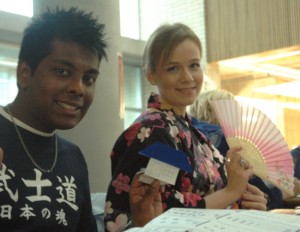
Jassneal Dass and Nina Ramsay demonstrated origami at the Japan table for International Education Week. (Photo by Sarah Casimong)
Dressed in traditional kimonos, members of Nihon Kwantlen Kurabu, otherwise known as Kwantlen’s Japanese Club, participated in International Education Week, with tables dedicated to Japanese calligraphy and origami, on Nov. 18.
Jassneal Dass, the Japanese club’s intercampus liaison, joined Nina Ramsay and other Japanese club students in creating origami.
“Personally, I’ve always had interest for [Japanese culture],” Dass said. “It started with video games first. Then anime on TV. Then I started learning more about the culture and it just became more interesting.
“I always wanted to learn the language because we didn’t have Japanese in high school. I was in French immersion so I was forced to learn French and I hated it. “
“[My Japanese] is pretty good,” Dass said. “I think I speak Japanese better than I speak Hindi, which is a good thing. I’ve been studying for three years. Some of my friends have been studying for seven years. They’re so much better than me.”
Dass admitted that Japanese calligraphy was challenging at first, but after writing out the characters hundreds of times, he has mastered the art.
He still, however, has yet to ace origami. The traditional Japanese art of paper folding is a traditional art form that dates back to the 17th century, according to House of Japan.
“I’m pretty terrible with art, so I’m not that great,” Dass admitted. “This is one of the first times I’m doing it. I’ve done it a few times in high school and elementary but I can’t even fold the paper correctly. I still need more practice on this.”
“I’ve always been interested in Japanese culture and when I got into university I was like, ‘Oh, there’s a Japanese class. Heck yes, I’m there,’” said Breena Kaye, who demonstrated calligraphy at the Japan table. “It’s actually a lot of fun.”
She encourages people who are interested in Japanese culture to take a Japanese language class at Kwantlen.
“You live and breathe Japanese for a semester,” Kaye said. “You get to learn something different instead of sitting in a classroom getting to learn people talk for an hour and a half. You get to really interact with your teacher, you get to interact with each other and it’s a really good way to learn.”
The Japanese Club meets at both the Surrey and Richmond campuses. It delves into Japanese culture, anime and manga, as well as Japanese history and cuisine.
Meeting are held in Richmond on Tuesdays at 1 p.m. in room 1815 and in Surrey on Thursdays at 1 p.m. in room D326, Fir building.
For more information, visit the Japanese club’s Facebook page.



